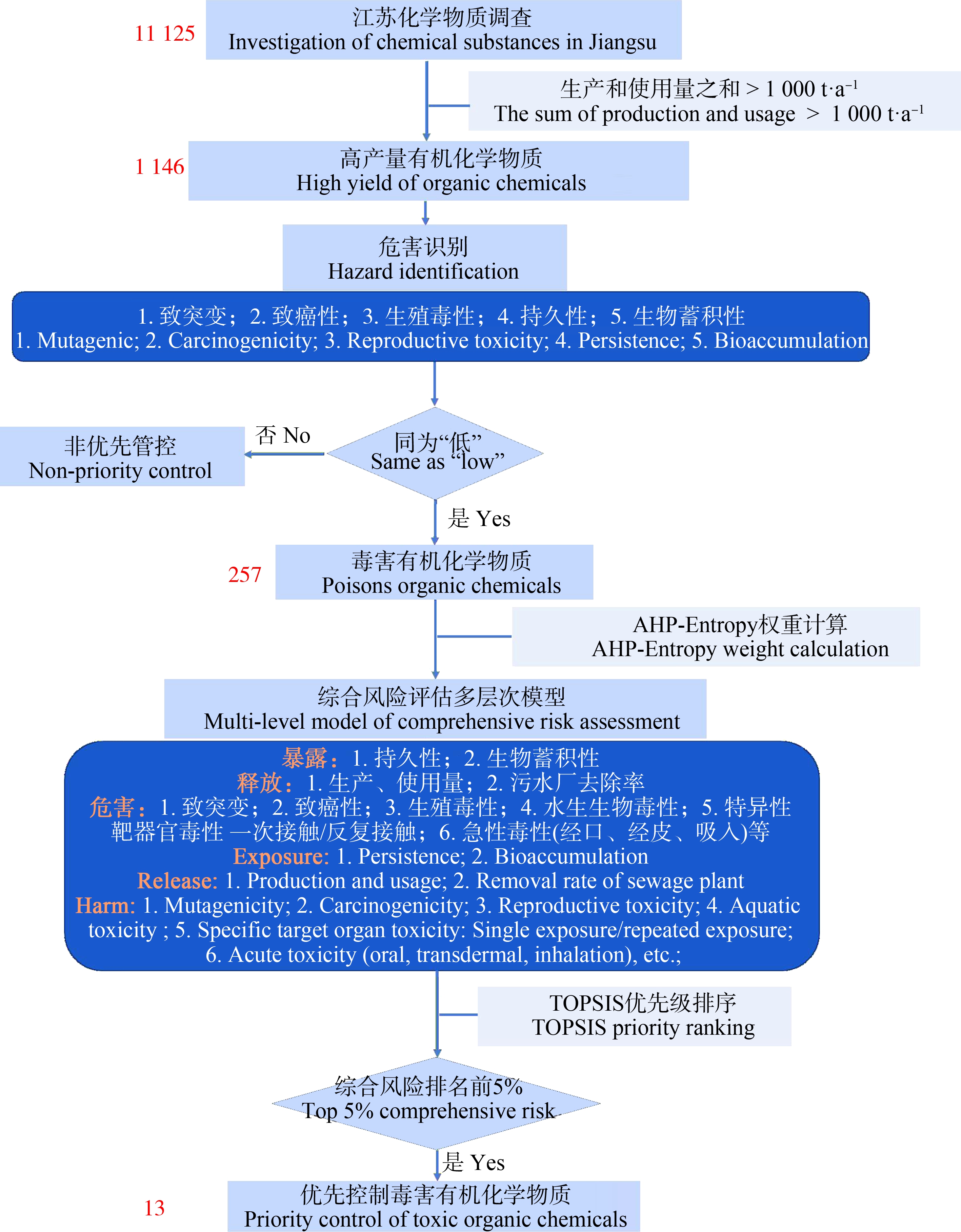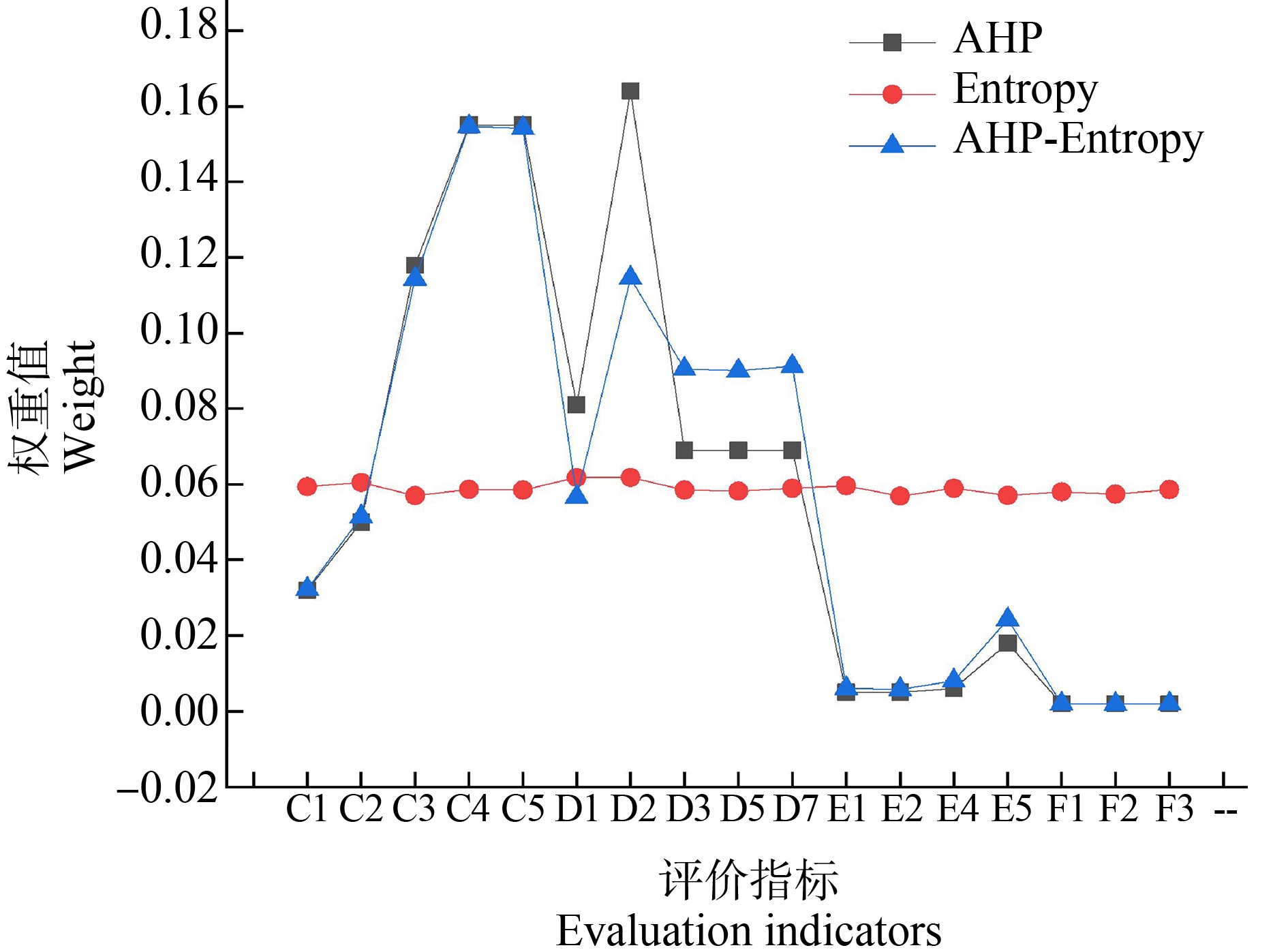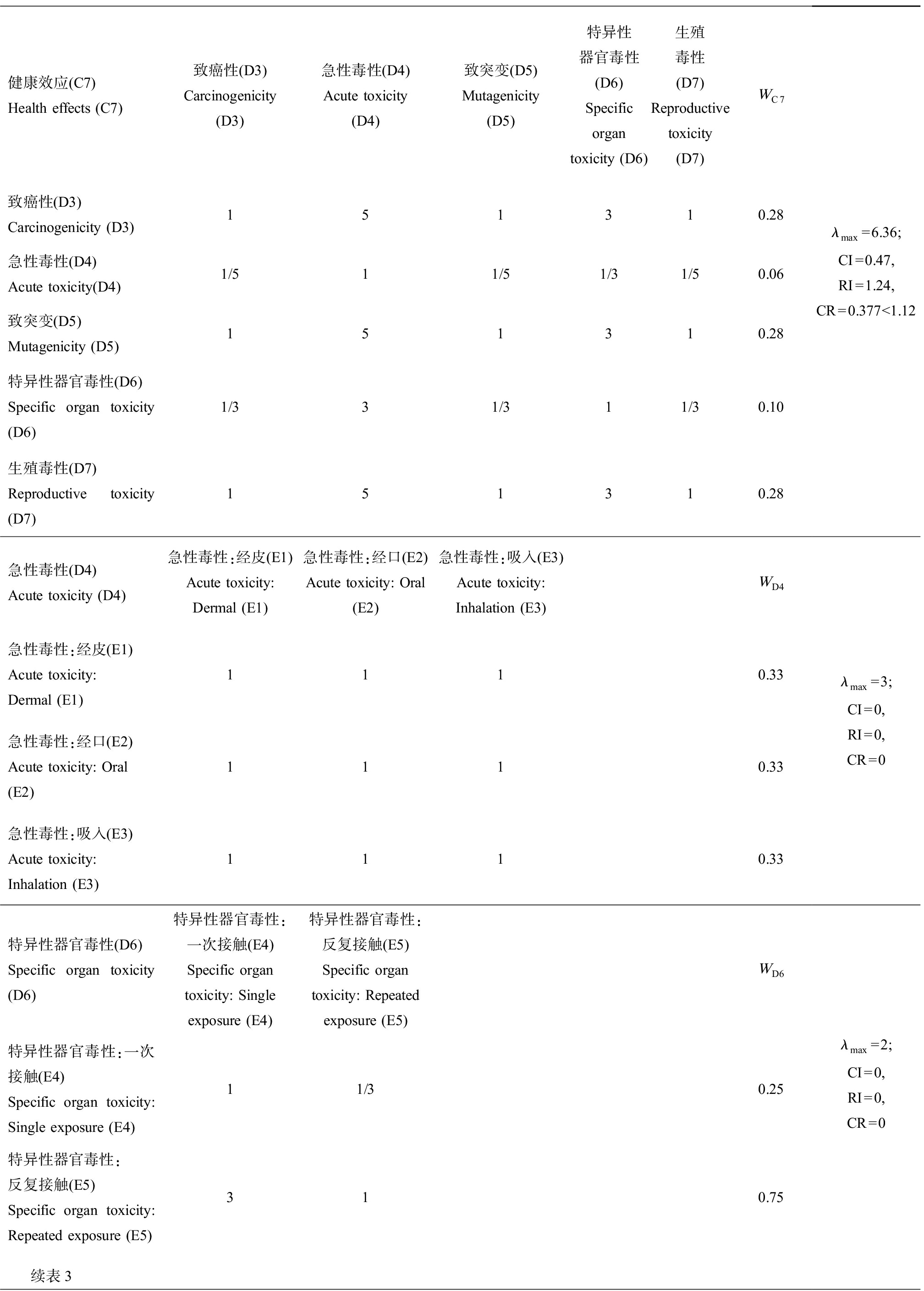“十四五”规划和2035年远景目标纲要指出“重视新污染物治理”。新污染物指新近产生或被新近认识的、任何人工合成或自然存在的化学物质或微生物,其环境赋存浓度可引起显著的已知或可疑的毒害作用[1]。毒害有机化学物质源头管控是预防新污染物产生的关键措施之一。由于毒害有机化学物质种类多、数量、环境健康危害具有差异性,管理部门全面开展管控不现实[2]。基于“优先控制”策略,筛选高产量、高环境健康风险的毒害有机化学物质,优先开展环境管理,已成为有效防控毒害有机化学物质环境健康风险的重要手段之一。
目前,“优先控制”策略已应用于污染物的筛选(表1)。美国、欧盟和加拿大等发达国家和地区选取毒性效应、暴露参数等作为评价指标,结合专家论证、综合得分等方法,确定优先污染物清单[3-6]。近年来,我国国内也开展了若干优先污染物的筛选研究。四川、福建和浙江等省通过专家论证的方式,建立了优先污染物清单。天津市选取健康毒性、检出率和降解性等指标,结合分级赋值和加和综合计算的方式,确定了水体中优先污染物清单[3]。胡凤琦等[7]基于赋分筛选技术,结合危害性、持久性和暴露参数,确定了重庆市涪陵工业园区优先评估化学品名录。丁琪琪等[6]构建多指标综合评分法,确定了涨渡湖水体中优先污染物清单。然而,国内“优先控制”技术研究仍存在一些不足:筛查指标不全面,未考虑化学品/污染物的释放潜力、人体健康风险等因素;依赖专家经验,主观性强[3,6]。因此,有必要采用主客观相结合的权重决策技术,全面考虑暴露、释放和危害场景,构建优先控制毒害有机化学物质筛查体系。
层次分析法(AHP)是具有扩展性的多准则决策算法,适用于多层次指标体系框架下的最优解评估[8]。目前,该方法已应用于优先污染物筛查研究[9-10]。然而,AHP对指标样本进行量化的过程,依赖专家经验设置不同的阈值和等级权重值,具有较强的主观因素,容易导致一定的量化偏差[11-12]。熵值法(Entropy)是一种客观评价技术,仅取决于所选样本及其评价指标,不存在人为影响[13-14]。此外,逼近理想解排序技术(TOPSIS)通过测量测试样本与最佳样本之间的差距来量化指标的适用性,可以避免阈值量化产生的偏差。TOPSIS-AHP-Entropy相结合不仅可以解决指标权重确定的主观性和离散化问题,而且可以实现不同指标样本的合理排序,适用于优先控制毒害有机化学物质的筛查。
江苏是我国化学物质的生产使用大省,全省拥有14家化工园区和15家化工集中区,部分化工企业沿江、濒海、环湖或位于敏感区域。然而,江苏省尚未确定优控毒害有机化学物质清单。2016年江苏省化学物质调查(统计年份为2015年)涵盖了全省化学原料和化学制品制造、石油化工和医药制造等化学物质生产使用较多的行业,调查结果能够反映全省化学物质的生产使用情况。因此,本研究以2015年江苏省生产使用的化学物质为对象,基于TOPSIS-AHP-Entropy技术,建立优先控制毒害有机化学物质筛查体系。该筛查体系有助于管理部门快速识别优控毒害有机化学物质,为新污染物治理奠定重要基础。
表1 国内外优先污染物筛查方法
Table 1 Screening methods of priority pollutants at home and abroad

清单List评价指标Evaluation indicators筛选方法Screening method美国水环境优先污染物Priority pollutants of water environment in the United States生产量、检出频次、监测方法、环境健康危害Production volume, detection frequency, monitoring method, environmental health hazard专家论证Expert verification欧盟水环境优先污染物Priority pollutants of EU water environment持久性、生物蓄积性、内分泌干扰性、毒性、暴露水平Persistence, bioaccumulation, endocrine disrupting, toxicity, exposure level监测和模型的优先设置方案、专家判断Priority setting scheme and expert judgment of monitoring and model加拿大环境优先污染物Environmental priority pollutants in Canada风险表征Risk characterization专家论证Expert verification日本优先污染物清单List of priority pollutants in Japan环境残留量、暴露潜力、毒性效应Environmental residues, exposure potential and toxic effects专家论证Expert verification英国优先污染物清单UK priority pollutant list持久性、生物富集性、毒性Persistence, bioaccumulation, toxicity专家论证Expert verification中国环境优先污染物黑名单Blacklist of environmental priority pollutants in China生产量、难降解、监测条件、毒性效应Production volume, refractory degradation, monitoring conditions, toxic effects专家论证Expert verification中国有毒有害水污染名录List of toxic and hazardous water pollution in China水环境赋存潜力、管控可行性Water environment occurrence potential, control feasibility专家论证Expert verification中国有毒有害大气污染名录List of toxic and harmful air pollution in China国家排放标准、监测方法、环境管理基础National emission standards, monitoring methods, environmental management basis专家论证Expert verification中国四川省优先污染物名单List of priority pollutants in Sichuan Province, China环境健康危害、环境检出Environmental health hazards and environmental detection专家评判Expert verification中国福建省水环境优先污染物名单List of priority pollutants of water environment in Fujian Province, China水系、废水排放量、重点行业Water system, wastewater discharge, key industries专家论证Expert verification中国天津市水体中优先污染物名单List of priority pollutants in surface water of Tianjin, China健康毒性、检出率、降解性、生物蓄积性Health toxicity, detection rate, degradability, bioaccumulation分级赋值、加权、加和综合计算Hierarchical assignment, weighting, summation and comprehensive calculation中国浙江省第一批环境优先污染物黑名单List of the first batch of environmental priority pollutants in Zhejiang Province, China生产量、使用量、进口量、排放量、毒性、环境事故Production, usage, imports, emissions, toxicity, environmental incidents专家论证Expert verification中国湖北省涨渡湖地表水环境优先污染物Priority pollutants of surface water environment in Zhangdu Lake, Hubei, China暴露水平、持久性、生物累积性、生态风险和人体健康风险Exposure levels, persistence, bioaccumulation, ecological risks and human health risks综合评分Overall rating
1 研究方法(Research methods)
1.1 筛查思路
优先控制毒害有机化学物质筛查体系如图1所示。(1)根据2015年江苏省化学物质生产使用数据,以“生产和使用量之和>1 000 t·a-1”为原则,确定高产量有机化学物质清单;(2)将具有持久性(P)、生物蓄积性(B)、致癌、致突变或生殖毒性的高产量有机化学物质,确定为毒害有机化学物质;(3)选取17个表征有机化学物质释放、暴露和危害潜力的参数,建立综合风险评估层次结构模型;(4)基于AHP-Entropy技术,计算各评估指标权重;(6)使用TOPSIS技术,对毒害有机化学物质开展优先级排序,确定优先控制毒害有机化学物质清单。
1.2 指标及数据收集
本研究选取表征有机化学物质释放、暴露和危害潜力的参数开展江苏省优先控制毒害有机化学物质筛查。物质向环境释放的总量与生产使用及环保治理设施去除率有关。理论上,生产使用越大,环保治理设施去除率越低,向环境释放的潜力也越大。因此,释放参数选取生产量、使用量和污水处理厂去除率。有机化学物质生产、使用量来自2015年江苏省化学物质调查的结果。基于US EPA EPI Suite软件,计算有机化学物质污水处理厂去除率[15]。

图1 优先控制毒害有机化学物质筛查思路
Fig. 1 Screening strategy for priority control of toxic organic chemicals
暴露参数包括持久性(P)和生物蓄积性(B)。P、B属性是反映有机化学物质在时间维度和空间维度(食物链传递)迁移和传递的重要指标[16]。P的判断参照REACH注册的化学物质信息[17],分为高持久性(vP)、P和非持久性(N)。当REACH注册的有机化学物质信息数据缺失时,使用加拿大的分类结果进行补充[18]。B判断方法与P判断方法一致,分为高生物富集性(vB)、B和非富集性(N)。
危害参数包括生态效应和健康效应。生态效应考虑水生急慢性毒性。健康效应包括致癌、致突变、生殖毒性(CMR)、特定靶器官毒性和哺乳动物急性毒性。化学物质的致癌性判断结果以国际癌症研究中心(IARC)致癌物分类为主[19],以德国工作场所化学有害因素职业接触限值(MAK)进行补充[20]。水生急慢性毒性、致突变、生殖毒性、特定靶器官毒性和哺乳动物急性毒性来源于日本的全球化学品统一分类和标签制度(GHS)[21]。
1.3 赋分标准
毒害有机化学物质17个评价指标中,包含定量和定性判断,且部分数据存在数量级的差异,因此采用分级赋值的方式,实现数据的定量化和标准化。各评价指标总分100,具有最大暴露、释放或危害潜力的等级分值最高,其余等级的赋值计算公式为总分除以该等级在指标中的危害排序,无效应或现有数据无法对其效应进行分类的,赋值1,具体赋分标准如表2所示。
1.4 综合风险评估层次结构模型构建
根据选取的毒害有机化学物质筛查指标,构建综合风险评估的递阶层次结构模型(图2)。第一层级为本研究的目的:毒害有机化学物质综合风险评估;第二层级论述了筛查考虑的主要因素,包括释放、暴露和危害3个方面。第3级为各因素包含的评价指标,共17个。
1.5 AHP-Entropy权重计算
根据综合风险评估层次结构模型,分别计算17个评价指标的AHP、Entropy和AHP-Entropy的权重值。

图2 毒害有机化学物质综合风险评估层次结构模型
Fig. 2 Hierarchical structure model for comprehensive risk assessment of toxic organic chemicals
表2 化学物质评价指标分级赋分表
Table 2 Graded score table of chemical substance evaluation index

评价指标Evaluation indicators分级Classification分值Score持久性Persistence高持久性(vP) High persistence (vP)100持久性(P) Persistence (P)50无持久性或不确定 No persistence or uncertainty1生物蓄积性Bioaccumulation高生物蓄积性(vB) High bioaccumulation (vB)100生物蓄积性(B) Bioaccumulation (B)50无生物蓄积性或不确定 No bioaccumulation or uncertainty1致癌性Carcinogenicity11002A(2)502B(3)333(4)25未分类Unclassified1生殖毒性、致突变性Reproductive toxicity, mutagenicity1A1001B50233未分类Unclassified1哺乳动物急性毒性(经口、经皮、吸入)、特性靶器官毒性(一次接触、反复接触)、水生急性、水生慢性毒性Mammalian acute toxicity (oral, dermal, inhalation), characteristic target organ toxicity (single exposure, repeated exposure), aquatic acute, aquatic chronic toxicity1100250333425522未分类Unclassified1生产量、使用量Production, usage生产(使用)量排名前20% Top 20% in production (use)100生产(使用)量排名在20%~40% The production (use) ranks 20%~40%50生产(使用)量排名在40%~60% The production (use) ranks 40%~60%33生产(使用)量排名60%~80% The production (use) ranks 60%~80%25生产(使用)量排名后20% The bottom 20% of production (use) 20污水处理厂去除率Removal rate of sewage treatment plant80%<去除率≤100% 80%
(1)AHP权重。根据不同参数的优先级,建立比较矩阵,按照1~9标度法进行AHP权重量化,并通过一致性检验。具体计算步骤如下:
设p1, p2, …, pm为指标参数,w1, w2, …, wj为参数的归一化权向量,需满足:
(1)
根据1~9标度法量化各指标重要性,形成m×m维的成对比较矩阵:

(2)
式中:aij表示参数pi和pjWi/Wj的权重比,aij=1,aij=1/aji。
若成对比较矩阵A中的任何i,j,k=1,2,…,m满足aij=aikakj,则称A为完全一致矩阵;否则它不是一个完全一致的矩阵。可以通过求解以下特征方程来获得权向量(W)
AW=λmaxA
(3)
式中:λmax为成对比较矩阵A的最大特征值。成对比较矩阵A的一致性需要在可接受的一致性范围内。使用一致性比(CR)进行检验:
(4)
式中:RI为同阶矩阵的平均随机一致性,可从表中获得。如果CR满足要求,说明构建的成对比较矩阵的一致性是可以接受。
(2)Entropy权重。根据评价指标,构建初始矩阵(式5),并使用式(6)对初始数据进行标准化。

(5)
(6)
式中:![]() 和
和![]() 是初始矩阵第j列元素的最大值和最小值;yij为标准化后的值。
是初始矩阵第j列元素的最大值和最小值;yij为标准化后的值。
获取标准化评价矩阵后(式7),使用式(8)~式(10)计算各指标熵值。

(7)

(8)
(9)

(10)
式中:Pij是评价指标得分;eij是索引的信息熵;10-4是修正指数,bij是Entropy权重值。
(3)AHP-Entropy。基于AHP和Entropy计算的权重值,确定各指标的AHP-Entropy值:
Kj=(Wj×bj)/(∑Wj×bj)
(11)
式中:Wj是AHP权重值,bj是Entropy权重值,Kj为AHP-Entropy权重值。
1.6 得分与排序
采用TOPSIS算法,开展毒害有机化学物质优先级排序,并选取总得分在前20%的毒害化学物质,纳入江苏省优先控制化学物质清单。TOPSIS计算的具体步骤为:
(1)17个评价指标标准化转换
xN=(xi-xmin)/(xmax-xmin)
(12)
式中:xi为指标样本值,xmax和xmin分别为该评价指标的最大值和最小值。
(2)参数样本归一化,公式如下:
(13)
式中:xN,STD为归一化的值,![]() 是正样本值,并且xmean和xstd是样本平均值和标准差。
是正样本值,并且xmean和xstd是样本平均值和标准差。
(3)计算正负理想解![]() 和
和![]()
(14)
(15)
(4)计算到正负理想解的距离:
(16)
(17)
(5)TOPSIS得分:
(18)
1.7 筛查模型验证
将筛查的优控毒害有机化学物质清单与国内外优控清单比对,确定模型的合理性。
2 结果与讨论(Results and discussion)
2.1 江苏省毒害化学物质识别
根据2015年江苏省化学物质生产使用结果,江苏省化学物质种类11 125种,其中生产和使用量之和>1 000 t·a-1的有机化学物质有1 146种,列为高产量有机化学物质。基于“具有潜在P、B、致癌性、致突变和生殖毒性中的任一一项即为毒害有机化学物质”的筛选原则,确定257种毒害有机化学物质。根据用途分类看,中间体和化工原料最多,分别占据25.68%和24.51%(图3)。
2.2 AHP-Entropy权重确定
根据1~9标度法,对相同层次的因素进行两两比较,构建各层次的判断矩阵,计算各评价指标的AHP权重值,并使用随机一致性比率(CR)检验矩阵的一致性。如表3所示,判断矩阵中,二阶矩阵的CR值均为0,三阶矩阵CR值均<0.58,五阶矩阵CR值<1.12。该结果表明,本研究构建的判断矩阵的一致性可接受。
根据各阶矩阵权重值的计算结果,确定17个评价指标的AHP权重,如表3所示。结果显示,污水处理厂去除率、P、B、致癌、致突变和生殖毒性权重值相对较高。这与我国优先控制化学品的确定原则相一致:具有P和B属性;或者属于已知的人类致癌物、引起人类生殖细胞发生可遗传突变或人类生殖毒物的化学品,纳入优先控制化学品清单。
使用公式(5)~(10),计算各指标的Entropy权重值(表4)。结果显示,Entropy确定权重值上下浮动幅度不明显,说明毒害有机化学物质评价指标的数据差异性较低。
AHP、Entropy和AHP-Entropy这3种方法确定的评价指标权重值比对如图4所示。由于Entropy确定的各指标权重值趋于一条直线,对最终权重值的确定影响小,因此AHP-Entropy确定的指标权重值走势与层次分析法基本相同。17个权重指标中,C3(P)、C4(B)、D2(水生慢性毒性)、D3(致癌性)、D5(致突变)和D7(生殖毒性)权重值较大,对筛查结果的影响相对较大。

图3 江苏省有机毒害化学物质分类情况
Fig. 3 Classification of toxic organic chemical substances in Jiangsu Province

图4 评价指标权重值比对
Fig. 4 Comparison of evaluation index weight values
2.3 江苏省优控毒害有机化学物质清单
基于TOPSIS技术,结合上文确定的17个评价指标权重值,开展257种毒害有机化学物质的综合风险排序,排名前5%(13种)的物质列入江苏省优先控制毒害化学物质清单。如表5所示,综合风险前3位的物质分别为环氧乙烷、蒽和毒死蜱。环氧乙烷属于持久性有机污染物,具有潜在的致癌性、生殖细胞致突变性及生殖毒性。蒽属于多环芳烃类物质,具有高持久性、生物富集性和水生生物毒性,在江苏省地表水、沉积物和大气中均有检出[22-24]。毒死蜱是我国使用最广泛的有机磷农药之一,属于持久性有机污染物,具有生物富集性和生物毒性。有研究表明,江苏省农业区域毒死蜱对2岁婴儿造成潜在健康风险[25]。四氯苯酐属于医药、农药和染料中间体,具有潜在的持久性、生物富集性和水生毒性效应。三氯乙醛属于农药、医药和有机合成产品的生产原料,也是自来水中氯化消毒副产物之一,具有一定的致癌、致突变性及生殖毒性,其急性经口、经皮肤毒性症状明显。有研究发现,苏州地区部分饮用水中三氯乙醛最大值为15 μg·L-1,高于国家标准限值[26]。
2.4 清单比对
本研究基于TOPSIS-AHP-Entropy技术,综合考虑毒害化学物质释放、暴露和危害潜力,筛选了江苏省优先控制毒害有机化学物质清单。由于江苏省目前尚未出台优先管控清单,本研究将建立的江苏省优控毒害有机化学物质清单与国内外相关管控清单比对,确定筛查策略的合理性。如表5所示,11种物质已被列入国内外管控清单中,纳入率为84.6%。其中,蒽、邻甲苯胺、六溴环十二烷、苯、乙醛、甲醛和四氯乙烯已列入我国优先控制化学品清单;环氧乙烷已列入加拿大优先物质清单;甲基环四硅氧烷已列入欧盟高关注度物质清单;毒死蜱已列入欧盟水框架优先控制污染清单。该结果表明,本研究构建的TOPSIS-AHP-Entropy技术能较准确筛选出高危害的毒害有机化学物质,具有一定的合理性。
表3 各层级判断矩阵及权重
Table 3 Judgment matrix and weight at each level

综合风险评估(A)Comprehensive risk assessment (A)释放(B1)Release (B1)暴露(B2)Exposure (B2)危害(B3)Harm (B3)WA释放(B1)Release (B1)121/20.20暴露(B2)Exposure (B2)1/211/20.31危害(B3)Harm (B3)2210.49λmax=3.05; CI=0.026, RI=0.58, CR=0.046<0.58释放(B1)Release (B1)生产量(C1)Production (C1)使用量(C2)Usage (C2)污水厂去除率(C3)Wastewater removal rate (C3)WB1生产量(C1)Production (C1)11/21/30.16使用量(C2)Usage (C2)211/30.25污水厂去除率(C3)Wastewater removal rate (C3)3310.59λmax=2; CI=0.023, RI=0.58, CR=0.040<0.58暴露(B2)Exposure (B2)持久性(C4)Persistence (C4)生物蓄积性(C5)Bioaccumulation (C5)WB2持久性(C4)Persistence (C4)110.5生物蓄积性(C5)Bioaccumulation (C5)110.5λmax=2; CI=0, RI=0, CR=0危害(B3)Harm (B3)生态效应(C6)Ecological effect (C6)健康效应(C7)Health effects (C7)WB3生态效应(C6)Ecological effect (C6)11/20.33健康效应(C7)Health effects (C7)210.67λmax=2; CI=0, RI=0, CR=0生态效应(C6)Ecological effect (C6)水生急性毒性(D1)Acute aquatic toxicity (D1)水生慢性毒性(D2)Chronic aquatic toxicity (D2)WC6水生急性毒性(D1)Acute aquatic toxicity (D1)11/20.33水生慢性毒性(D2)Chronic aquatic toxicity (D2)210.67λmax=2; CI=0, RI=0, CR=0续表3

健康效应(C7)Health effects (C7)致癌性(D3)Carcinogenicity (D3)急性毒性(D4)Acute toxicity(D4)致突变(D5)Mutagenicity (D5)特异性器官毒性(D6)Specific organ toxicity (D6)生殖毒性(D7)Reproductive toxicity (D7)WC7致癌性(D3)Carcinogenicity (D3)151310.28急性毒性(D4)Acute toxicity(D4)1/511/51/31/50.06致突变(D5)Mutagenicity (D5)151310.28特异性器官毒性(D6)Specific organ toxicity (D6)1/331/311/30.10生殖毒性(D7)Reproductive toxicity (D7)151310.28λmax=6.36; CI=0.47, RI=1.24, CR=0.377<1.12急性毒性(D4)Acute toxicity (D4)急性毒性:经皮(E1)Acute toxicity: Dermal (E1)急性毒性:经口(E2)Acute toxicity: Oral (E2)急性毒性:吸入(E3)Acute toxicity: Inhalation (E3)WD4急性毒性:经皮(E1)Acute toxicity: Dermal (E1)1110.33急性毒性:经口(E2)Acute toxicity: Oral (E2)1110.33急性毒性:吸入(E3)Acute toxicity: Inhalation (E3)1110.33λmax=3; CI=0, RI=0, CR=0特异性器官毒性(D6)Specific organ toxicity (D6)特异性器官毒性:一次接触(E4)Specific organ toxicity: Single exposure (E4)特异性器官毒性:反复接触(E5)Specific organ toxicity: Repeated exposure (E5)WD6特异性器官毒性:一次接触(E4)Specific organ toxicity: Single exposure (E4)11/30.25特异性器官毒性:反复接触(E5)Specific organ toxicity: Repeated exposure (E5)310.75λmax=2; CI=0, RI=0, CR=0续表3

急性毒性:吸入(E3)Acute toxicity: Inhalation (E3)急性毒性:吸入(空气) (F1)Acute toxicity: Inhalation (gases) (F1)急性毒性:吸入(蒸气) (F2)Acute toxicity: Inhalation (vapours) (F2)急性毒性:吸入(粉尘) (F3)Acute toxicity: Inhalation (dusts and mists) (F3)WE3急性毒性:吸入(空气)(F1)Acute toxicity: Inhalation (gases) (F1)1110.33急性毒性:吸入(蒸气)(F2)Acute toxicity: Inhala-tion (vapours) (F2)1110.33急性毒性:吸入(粉尘)(F3)Acute toxicity: Inhala-tion (dusts and mists) (F3)1110.33λmax=3; CI=0, RI=0, CR=0
注:λmax表示最大特征值;CI表示一致性;RI表示同阶矩阵的平均随机一致性;CR表示一致性比。
Note: λmax means largest eigenvalue; CI means consistency; RI means average random consistency of the same order matrix; CR means consistency ratio.
表4 评价指标权重值
Table 4 Evaluation index weight value

评价指标Evaluation index生产量(C1)Production (C1)使用量(C2)Usage (C2)污水厂去除率(C3)Wastewater removal rate (C3)持久性(C4)Persistence (C4)生物蓄积性(C5)Bioaccumulation (C5)水生急性毒性(D1)Acute aquatic toxicity (D1)水生慢性毒性(D2)Chronic aquatic toxicity (D2)Wi0.0320.050.1180.1550.1550.0540.109bi0.05940.06050.05700.05870.05850.06180.0618Ki0.03200.05140.11430.15470.15410.05670.1145评价指标Evaluation index致癌性(D3)Carcinogenicity (D3)致突变(D5)Mutagenicity (D5)生殖毒性(D7)Reproductive toxicity (D7)急性毒性:经皮(E1)Acute toxicity: Dermal (E1)急性毒性:经口(E2)Acute toxicity: Oral (E2)特异性器官毒性:一次接触(E4)Specific organ toxicity: Single exposure (E4)特异性器官毒性:反复接触(E5)Specific organ toxicity: Repeated exposure (E5)Wi0.0910.0910.0910.0060.0060.0080.025bi0.05850.05820.05900.05960.05690.05900.0571Ki0.09050.09000.09130.00610.00580.00800.0243评价指标Evaluation index急性毒性:吸入(空气) (F1)Acute toxicity: Inhalation (gases) (F1)急性毒性:吸入(蒸气)(F2)Acute toxicity: Inhalation (vapours) (F2)急性毒性:吸入(粉尘)(F3)Acute toxicity: Inhalation (dusts and mists) (F3)Wi0.0020.0020.002bi0.05800.05740.0586Ki0.00200.00200.0020
表5 江苏省优先控制毒害有机化学物质清单
Table 5 List of priority controlled toxic organic chemicals in Jiangsu Province

排名RankCAS号CAS No.化学品名称Chemical 得分Score国内外清单比对情况List comparison between home and abroad毒害效应Toxic effects175-21-8环氧乙烷Ethylene oxide76.8加拿大优先物质清单List of Canadian Priority Sub-stancesP;致癌性:2A;致突变性:类别1B;生殖毒性:类别1B;特定靶器官毒性(一次接触):类别1;特定靶器官毒性(反复接触):类别1;水生急性毒性:类别3P; Carcinogenicity: 2A; Mutagenicity: Category 1B; Reproductive toxicity: Category 1B; Specific target organ toxicity (single exposure): Category 1; Spe-cific target organ toxicity (repeated exposure): Cat-egory 1; Aquatic acute toxicity: Category 32120-12-7蒽Anthracene75.0优先控制化学品名录(第二批)(中国)、清洁水法案-优先控制物质清单(美国)、欧盟高关注度物质清单等Priority Control of Chemicals (Second Batch) in China, Clean Water Act -List of Substances of Priority Control in USA, EU List of Substances of High Concern, etc.vP;B;致癌性:3;水生急性毒性:类别1;水生慢性毒性:类别1;特定靶器官毒性(一次接触):类别3vP; B; Carcinogenicity: 3; Aquatic acute toxicity: Category 1; Aquatic chronic toxicity: Category 1; Specific target organ toxicity (one exposure): Cate-gory 332921-88-2毒死蜱Chlorpyrifos69.8欧盟水框架优先控制污染清单The EU Water Framework Priori-tizes Pollution Control Invento-riesP;B;生殖毒性:类别2;特定靶器官毒性(一次接触):类别1;特定靶器官毒性(反复接触):类别1P; B; Reproductive toxicity: Category 2; Specific target organ toxicity (single exposure): Category 1; Specific target organ toxicity (repeated exposure): Category 14556-67-2八甲基环四硅氧烷Octamethylcyclotetrasiloxane69.0欧盟高关注度物质清单EU List of Substances of High ConcernP;B;水生慢性毒性:类别1;水生急性毒性:类别1P; B; Aquatic chronic toxicity: Category 1; Aquatic acute toxicity: Category 1575-87-6三氯乙醛Trichloroacetaldehyde66.5/致癌性:2A;致突变性:类别1B;生殖毒性:类别2;特定靶器官毒性(一次接触):类别1;急性吸入毒性:类别1Carcinogenicity: 2A; Mutagenicity: Category 1B; Reproductive toxicity: Category 2; Specific target organ toxicity (single exposure): Category 1; Acute inhalation toxicity: Category 1695-53-4邻甲苯胺o-toluidine64.3优先控制化学品名录(第二批)(中国)、欧盟高关注度物质清单Priority Control of Chemicals (Second Batch) in China, EU List of Substances of High Concern致癌性:1;水生急性毒性:类别1;水生慢性毒性:类别1;定靶器官毒性(一次接触):类别1;特定靶器官毒性(反复接触):类别1Carcinogenicity: 1; Aquatic acute toxicity: Category 1; Aquatic chronic toxicity: Category 1; Targeted organ toxicity (primary exposure): Category 1; Spe-cific target organ toxicity (repeated exposure): Cat-egory 1

续表5排名RankCAS号CAS No.化学品名称Chemical 得分Score国内外清单比对情况List comparison between home and abroad毒害效应Toxic effects767-66-3三氯甲烷Trichloromethane63.8优先控制化学品名录(第一批)(中国)、欧盟水框架优先控制污染清单、美国水环境优先污染物清单等Priority Control of Chemicals (First Batch) in China, EU Water Framework Priority Control Pol-lution Inventory, U.S. Water En-vironment Priority Pollutants List, etc.P;致癌性:2B;致突变性:2A;生殖毒性:2;特定器官毒性(一次接触):类别1;特定靶器官毒性(反复接触):类别1;水生急性毒性:类别3;水生慢性毒性:类别1P; Carcinogenicity: 2B; Mutagenicity: 2A; Repro-ductive toxicity: 2; Organ-specific toxicity (single contact): Category 1; Specific target organ toxicity (repeated exposure): Category 1; Aquatic acute tox-icity: Category 3; Aquatic chronic toxicity: Catego-ry 183194-55-6六溴环十二烷Hexabromocyclododecane63.1优先控制化学品名录(第二批)(中国)、欧盟高关注度物质清单、斯德哥尔摩公约管控物质Priority Control of Chemicals (Second Batch) in China, EU List of Substances of High Concern, substances controlled by the Stockholm ConventionP;B;生殖毒性:2P; B; Reproductive toxicity: 2971-43-2苯Benzene62.5优先控制化学品名录(第二批)(中国)、欧盟水框架优先控制污染清单、美国水环境优先污染物清单等Priority Control of Chemicals (Second Batch) in China, EU Water Framework Priority Con-trol Pollution Inventory, U.S. Water Environment Priority Pol-lutants List, etc.P;致癌性:1;致突变性:2A;水生急性毒性:类别2;水生慢性毒性:类别2P; Carcinogenicity: 1; Mutagenicity: 2A; Aquatic a-cute toxicity: Category 2; Aquatic chronic toxicity: Category 21075-07-0乙醛Acetaldehyde61.4优先控制化学品名录(第一批)(中国)Priority Control of Chemicals (First Batch) in China致癌性:1;特定靶器官毒性(一次接触):类别1;特定靶器官毒性(反复接触):类别1Carcinogenicity: 1; Specific target organ toxicity (single exposure): Category 1; Specific target organ toxicity (repeated exposure): Category 11150-00-0甲醛Formaldehyde60.6优先控制化学品名录(第一批)(中国)Priority Control of Chemicals (First Batch) in China致癌性:1;致突变性:类别2;定靶器官毒性(一次接触):类别1;特定靶器官毒性(反复接触):类别1;水生急性毒性:类别2Carcinogenicity: 1; Mutagenicity: Category 2; Tar-geted organ toxicity (primary exposure): Category 1; Specific target organ toxicity (repeated expo-sure): Category 1; Aquatic acute toxicity: Category 2

续表5排名RankCAS号CAS No.化学品名称Chemical 得分Score国内外清单比对情况List comparison between home and abroad毒害效应Toxic effects12117-08-8四氯苯酐Tetrachlorophthalic anhydride60.6/P;B;特定靶器官毒性(一次接触):类别1;水生急性毒性:类别1;水生慢性毒性:类别1P; B; Specific target organ toxicity (single expo-sure): Category 1; Aquatic acute toxicity: Category 1; Aquatic chronic toxicity: Category 113127-18-4四氯乙烯Tetrachloroethylene60.3优先控制化学品名录(第一批)(中国)、欧盟水框架优先控制污染清单、美国水环境优先污染物清单等Priority Control of Chemicals (First Batch) in China, EU Water Framework Priority Control Pol-lution Inventory, U.S. Water En-vironment Priority Pollutant In-ventory, etc.vP;水生急性毒性:类别1;水生慢性毒性:类别1;致癌性:2A;定靶器官毒性(一次接触):类别1;特定靶器官毒性(反复接触):类别1;生殖毒性:类别2vP; Aquatic acute toxicity: Category 1; Aquatic chronic toxicity: Category 1; Carcinogenicity: 2A; Targeted organ toxicity (primary exposure): Cate-gory 1; Specific target organ toxicity (repeated ex-posure): Category 1; Reproductive toxicity: Catego-ry 2
本研究根据有机化学物质的生产使用量、P、B、致癌、致突变和生殖毒性,确定毒害有机化学物质。随后综合选取17个释放、暴露和危害潜力参数,构建综合风险评估层次结构模型。基于TOPSIS-AHP-Entropy技术,开展参数权重计算及毒害有机化学物质优先级排序,建立了优先控制毒害有机化学物质筛查体系,并应用于江苏省优控毒害有机化学物质清单的建立。结果显示,通过该筛查体系确定的13种优控毒害有机化学物质中,11种物质已纳入我国优先控制化学品、加拿大优先物质清单等国内外优控清单[27-28],表明筛查体系具有良好的合理性。该项体系的建立,有助于管理部门快速识别区域优控毒害有机化学物质,为新污染物治理奠定重要基础。但是,本筛查技术也存在一些不足之处:毒害有机化学物质生态危害表征仅考虑水生毒性,未包含其在其他环境介质的潜在危害。因此,后续研究应重点增加毒害有机化学物质生态效应指标,更全面反映其生态危害。
[1] 王佳钰, 王中钰, 陈景文, 等. 环境新污染物治理与化学品环境风险防控的系统工程[J]. 科学通报, 2022, 67(3): 267-277
Wang J Y, Wang Z Y, Chen J W, et al. Environmental systems engineering consideration on treatment of emerging pollutants and risk prevention and control of chemicals [J]. Chinese Science Bulletin, 2022, 67(3): 267-277 (in Chinese)
[2] Bu Q W, Wang D H, Wang Z J. Review of screening systems for prioritizing chemical substances [J]. Critical Reviews in Environmental Science and Technology, 2013, 43(10): 1011-1041
[3] 王一喆, 张亚辉, 赵莹, 等. 国内外环境优先污染物筛选排序方法比较[J]. 环境工程技术学报, 2018, 8(4): 456-464
Wang Y Z, Zhang Y H, Zhao Y, et al. Comparison on screening and sorting methods of environmental priority pollutants at home and abroad [J]. Journal of Environmental Engineering Technology, 2018, 8(4): 456-464 (in Chinese)
[4] United States Environmental Protection Agency (US EPA). Toxic and priority pollutants under the Clean Water Act [R]. Washington DC: US EPA, 1977
[5] Council E. Directive 2000/60/EC of the European Parliament and of the Council of 23 October 2000 establishing a framework for community action in the field of water [R]. European Community, 2000
[6] 丁琪琪, 龚雄虎, 王兆德, 等. 基于多指标综合评分法筛选地表水环境优先污染物——以湖北涨渡湖为例[J]. 湖泊科学, 2022, 34(1): 90-108
Ding Q Q, Gong X H, Wang Z D, et al. A proposed multi-criteria scoring method for identifying priority pollutants in surface water: A case study of Lake Zhangdu, Hubei Province [J]. Journal of Lake Sciences, 2022, 34(1): 90-108 (in Chinese)
[7] 胡凤琦, 胡洁, 卓丽, 等. 重庆市涪陵工业园区优先评估化学品名录筛查[J]. 环境科学与技术, 2020, 43(S2): 262-270
Hu F Q, Hu J, Zhuo L, et al. Screening on the list of priority assessment chemicals in Fuling industrial park, Chongqing [J]. Environmental Science & Technology, 2020, 43(S2): 262-270 (in Chinese)
[8] Li Y, Wu L Y, Han Q, et al. Estimation of remote sensing based ecological index along the Grand Canal based on PCA-AHP-TOPSIS methodology [J]. Ecological Indicators, 2021, 122: 107214
[9] 朱菲菲, 秦普丰, 张娟, 等. 我国地下水环境优先控制有机污染物的筛选[J]. 环境工程技术学报, 2013, 3(5): 443-450
Zhu F F, Qin P F, Zhang J, et al. Screening of priority organic pollutants in groundwater of China [J]. Journal of Environmental Engineering Technology, 2013, 3(5): 443-450 (in Chinese)
[10] 段思聪. 河北省流域水环境优先控制污染物筛选方法研究[J]. 煤炭与化工, 2017, 40(11): 146-150, 160
Duan S C. Study on screening method of pollutants in water environment priority control in Hebei Province [J]. Coal and Chemical Industry, 2017, 40(11): 146-150, 160 (in Chinese)
[11] 刘子琦, 郭炳晖, 程臻, 等. 基于熵值模糊层次分析法的科技战略评价[J]. 计算机科学, 2020, 47(S1): 1-5
Liu Z Q, Guo B H, Cheng Z, et al. Science and technology strategy evaluation based on entropy fuzzy AHP [J]. Computer Science, 2020, 47(S1): 1-5 (in Chinese)
[12] Joshi R, Banwet D K, Shankar R. A Delphi-AHP-TOPSIS based benchmarking framework for performance improvement of a cold chain [J]. Expert Systems with Applications, 2011, 38(8): 10170-10182
[13] Amiri V, Kamrani S, Ahmad A, et al. Groundwater quality evaluation using Shannon information theory and human health risk assessment in Yazd Province, central plateau of Iran [J]. Environmental Science and Pollution Research, 2021, 28(1): 1108-1130
[14] Li P Y, Qian H, Wu J H. Application of set pair analysis method based on entropy weight in groundwater quality assessment-A case study in Dongsheng City, northwest China [J]. E-Journal of Chemistry, 2011, 8: 879683
[15] United States Environmental Protection Agency (US EPA). Estimation Program Interface (EPI) Suite. EPA.2013. [CP]. [2021-11-09]. http://www2.epa.gov/tscascreening-tools/epi-suitetm-estimation-program-interface. Last accessed 25/9/2015
[16] 卜庆伟, 王东红, 王子健. 基于风险分析的流域优先有机污染物筛查: 方法构建[J]. 生态毒理学报, 2016, 11(1): 61-69
Bu Q W, Wang D H, Wang Z J. A risk-based screening approach for priority organic contaminants at the watershed scale: Method development [J]. Asian Journal of Ecotoxicology, 2016, 11(1): 61-69 (in Chinese)
[17] European Chemicals Agency. Technical problems with ECHA’s public chemicals database [EB/OL]. [2021-11-09]. https://echa.europa.eu/information-on-chemicals
[18] Organization for Economic Co-operation and Development. Categorization results from the Canadian domestic substance list [EB/OL]. [2021-11-09]. https://canadachemicals.oecd.org/
[19] International Agency for Research on Cancer (IARC). Agents classified by the IARC monographs, volumes 1-132 [R]. Lyon: IARC, 2022
[20] Volz N, Greim H, Hartwig A. Permanent Senate Commission for the Investigation of Health Hazards of Chemical Compounds in the Work Area-An example about the procedure in threshold [R]. Permanent Senate Commission, 2015
[21] National Institute of Technology and Evaluation (Japan). GHS Information [EB/OL]. [2021-11-08]. https://www.nite.go.jp/chem/
[22] 蔡杨, 李伟, 左雪燕, 等. 盐城滨海湿地土壤多环芳烃分布特征及影响因素[J]. 生态环境学报, 2021, 30(6): 1249-1259
Cai Y, Li W, Zuo X Y, et al. Distribution characteristics and influencing factors of PAHs in Yancheng coastal wetland soil [J]. Ecology and Environmental Sciences, 2021, 30(6): 1249-1259 (in Chinese)
[23] 汪庆庆, 马小莹, 徐斌, 等. 江苏四城市PM2.5中多环芳烃室外呼吸暴露健康风险评估[J]. 江苏预防医学, 2018, 29(2): 140-144, 207
Wang Q Q, Ma X Y, Xu B, et al. Outdoor inhalation exposure risk assessment of polycyclic aromatic hydrocarbons among PM2.5 in 4 Cities of Jiangsu Province [J]. Jiangsu Journal of Preventive Medicine, 2018, 29(2): 140-144, 207 (in Chinese)
[24] He H, Hu G J, Sun C, et al. Trace analysis of persistent toxic substances in the main stream of Jiangsu section of the Yangtze River, China [J]. Environmental Science and Pollution Research, 2011, 18(4): 638-648
[25] Liu P, Wu C H, Chang X L, et al. Assessment of chlorpyrifos exposure and absorbed daily doses among infants living in an agricultural area of the Province of Jiangsu, China [J]. International Archives of Occupational and Environmental Health, 2014, 87(7): 753-762
[26] 倪攀, 华一江, 杨海兵, 等. 苏州地区城乡生活饮用水水质调查与分析[J]. 环境卫生学杂志, 2011, 1(4): 10-13
Ni P, Hua Y J, Yang H B, et al. Analysis and investigation on the quality of drinking water in Suzhou urban and rural areas [J]. Journal of Environmental Hygiene, 2011, 1(4): 10-13 (in Chinese)
[27] 中华人民共和国环境保护部. 优先控制化学品名录(第一批)[S]. 北京: 中华人民共和国环境保护部, 2017
[28] 中华人民共和国生态环境部. 优先控制化学品名录(第二批)[S]. 北京: 中华人民共和国生态环境部, 2020